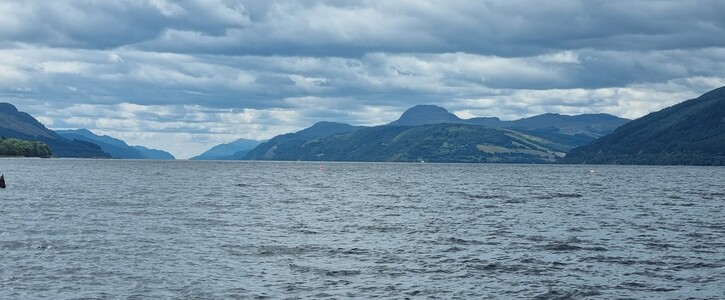1,000 signatures reached
To: Gillian Martin, Scottish Government Minister for Energy
Save Loch Ness: no more pump storage hydro in Loch Ness

Loch Ness is under threat from new and larger pump storage hydro developments. The proposed Loch Kemp pump storage scheme, combined with the existing Foyers, and the consented Red John schemes, will raise/lower the level of Loch Ness by up to 73cm (2ft 5") overnight. These dramatic fluctuations in water level will sterilise the shoreline ecology, disrupt natural currents within the loch and could raise the temperature of Loch Ness.
The developers of the Loch Kemp scheme acknowledge that the impact of multiple pump storage hydro schemes on the migration of juvenile wild salmon though Loch Ness is likely to be harmful. In addition flows down the River Ness will fluctuate constantly, and will be at rock bottom level, more often, and for longer duration. No appropriate measures have been put forward by the Loch Kemp developers to mitigate these impacts.
Loch Ness is the most famous loch in the world and an iconic tourism destination. Natural lochs, especially Loch Ness, should not be used for pump storage hydro. Pump storage hydro will be an important part of energy storage and generation in the future, but there are plenty more suitable sites within Scotland (including others within the Ness catchment which are already under consideration), where the environmental risks and constraints are fewer.
Why does this matter? Loch Ness is an iconic location, home to a legendary monster, supports a multitude of tourism related businesses and jobs, holds the greatest volume of water of any Scottish loch and sustains a unique ecosystem, with wild Atlantic salmon at its heart.
No loch, especially Loch Ness, should be subject to development on this scale. The cumulative impacts of development on this scale, on the ecology and hydrology of Loch Ness are not understood, nor has any attempt been made to provide answers. We are not against pump storage hydro per se, but they should to be located in less sensitive areas. We cannot allow our precious biodiversity to be trashed in what is akin to a gold rush for pump storage hydro developers. Planners and decision makers need to ensure that informed and strategic decisons are taken for the sake of the sustainability we all crave.
The developers of the Loch Kemp scheme acknowledge that the impact of multiple pump storage hydro schemes on the migration of juvenile wild salmon though Loch Ness is likely to be harmful. In addition flows down the River Ness will fluctuate constantly, and will be at rock bottom level, more often, and for longer duration. No appropriate measures have been put forward by the Loch Kemp developers to mitigate these impacts.
Loch Ness is the most famous loch in the world and an iconic tourism destination. Natural lochs, especially Loch Ness, should not be used for pump storage hydro. Pump storage hydro will be an important part of energy storage and generation in the future, but there are plenty more suitable sites within Scotland (including others within the Ness catchment which are already under consideration), where the environmental risks and constraints are fewer.
Why does this matter? Loch Ness is an iconic location, home to a legendary monster, supports a multitude of tourism related businesses and jobs, holds the greatest volume of water of any Scottish loch and sustains a unique ecosystem, with wild Atlantic salmon at its heart.
No loch, especially Loch Ness, should be subject to development on this scale. The cumulative impacts of development on this scale, on the ecology and hydrology of Loch Ness are not understood, nor has any attempt been made to provide answers. We are not against pump storage hydro per se, but they should to be located in less sensitive areas. We cannot allow our precious biodiversity to be trashed in what is akin to a gold rush for pump storage hydro developers. Planners and decision makers need to ensure that informed and strategic decisons are taken for the sake of the sustainability we all crave.
Why is this important?
We are seeking support from anyone concerned with the scale of pump storage hydro developments in Loch Ness. Loch Ness is the most famous loch in the world and is an iconic tourist destination. It's beautiful setting, legendary monster and rich biodiversity are at risk from these developments. The list of unknown potential side-effects of pump storage hydro on large lochs is extensive. For example, no research has been done on the impact of pump storage hydro on juvenile wild salmon as they migrate downstream through these lochs, and we think that pumping water on this huge scale will ultimately raise the famously cool temperatures of Loch Ness.
The cumulative impact of consenting so many pump storage hydro schemes in one loch are totally unknown and none of the developers seem willing to commit to researching these fundamental questions.
The sight of dolphins feeding on wild Atlantic salmon, within metres of the shore, at Chanonry Point is the greatest wildlife spectacle in the Highlands. This hugely popular tourist destination is at risk if wild Atlantic salmon continue to decline.
The cumulative impact of consenting so many pump storage hydro schemes in one loch are totally unknown and none of the developers seem willing to commit to researching these fundamental questions.
The sight of dolphins feeding on wild Atlantic salmon, within metres of the shore, at Chanonry Point is the greatest wildlife spectacle in the Highlands. This hugely popular tourist destination is at risk if wild Atlantic salmon continue to decline.

